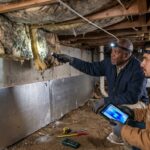Essential Guide to Foundation Repair: Ensuring a Strong and Stable Home
When it comes to homeownership, one of the most critical aspects that often gets overlooked is the foundation. Like the unsung hero of your house, the foundation bears the weight of all your dreams, furniture, and perhaps even a few too many holiday decorations. A solid foundation not only ensures structural integrity but also supports your family’s safety and well-being. So, let’s dig deep—pun intended—into the essential guide to foundation repair and make sure your home stands strong against the test of time!
Understanding Your Foundation
To appreciate the importance of foundation repair, it helps to first understand what a foundation is and its different types. Foundations generally fall into three categories:
1. **Basement Foundations**: These are typically built below ground level and can be made from concrete, stone, or masonry. They offer additional living space and storage but can also be prone to water issues.
2. **Crawl Space Foundations**: These elevate the home above the ground and provide a small space (usually 18 inches high) to access pipes and electrical systems. The downside? You may find yourself battling moisture and pests in that cozy little area.
3. **Slab Foundations**: A concrete slab is poured directly onto the ground, providing a strong base. While they are cost-effective, they can crack over time due to settlement or environmental factors.
Regardless of the type, all foundations are susceptible to issues, especially if they were built on poor soil or not constructed with enough care.
Signs Your Foundation Needs Attention
So, how do you know when your foundation is waving a red flag? Here are some signs to watch for:
– **Cracks in Walls or Ceilings**: Small hairline cracks could be normal settling, but large, jagged cracks may indicate a deeper issue. If your walls resemble a fractured puzzle, it might be time to call in the pros.
– **Uneven Floors**: Do you feel like you’re participating in an impromptu game of Twister every time you walk through your home? Uneven or sagging floors are a telltale sign of foundation problems.
– **Doors and Windows Sticking**: If you need a crowbar to open the front door, your foundation may have shifted. Doors and windows should smoothly open and close—not provide an unexpected workout.
– **Gaps Around Windows and Doors**: Pet doors should be the only gaps in your home’s exterior. If you start finding noticeable spaces around window frames or doors, that’s a signal your foundation might need a little TLC.
– **Outdoor Issues**: Check your yard for signs like cracked pavement, sinking patios, or sloped areas near your home; all can indicate problems with your foundation.
The Importance of Timely Repairs
Now that you’ve identified potential issues, let’s chat about why addressing these problems promptly is crucial. Ignoring foundation issues is much like letting a small crack in your windshield go unchecked; it may seem minor until it spreads like gossip at a family reunion.
1. **Safety Concerns**: A compromised foundation can lead to structural failures, putting your family at risk. The last thing you want is to turn your dream home into an episode of a disaster documentary.
2. **Increased Repair Costs**: Foundation repairs can quickly escalate in cost if left unattended. What starts as a small crack can lead to extensive damage requiring major repairs or even a complete replacement.
3. **Home Value**: Should you decide to sell your home, a damaged foundation will likely deter buyers and drastically lower your property value. No one wants to buy a “fixer-upper” when they meant to purchase a “move-in ready.”
4. **Insurance Challenges**: Many homeowners’ insurance policies don’t cover foundation repairs if they result from neglect. Always check your policy to avoid unwelcome surprises down the line.
Types of Foundation Repair Solutions
When it comes to repairing a foundation, there are various approaches depending on the severity of the issue. Some common methods include:
1. **Piering**: This method involves inserting steel piers deep into the ground beneath your foundation to stabilize it. Think of it as giving your home a sturdy pair of stilts to stand on.
2. **Slab Jacking**: If your foundation has settled unevenly, slab jacking can lift it back to its original level by injecting a grout mixture beneath it. It’s like giving your foundation a gentle push-up!
3. **Carbon Fiber Straps**: For bowing or buckling walls, carbon fiber straps can provide reinforcement without taking up much space. They are lightweight yet extraordinarily strong, making them a favorite choice among contractors.
4. **Wall Anchors**: If your basement walls are leaning, wall anchors can help pull them back into place. It’s like giving your walls a firm hug and saying, “You got this!”
5. **Drainage Solutions**: Sometimes, foundation issues arise from poor drainage. Installing a drainage system or sump pump can prevent water from accumulating around your foundation. Think of it as giving your foundation a protective raincoat.
Choosing the Right Contractor
Hiring a foundation repair contractor can feel like navigating a minefield. You want someone trustworthy who understands the nuances of your specific situation. Here are some tips for selecting the right professional:
– **Check Credentials**: Ensure the contractor is licensed, bonded, and insured. This can save you from future headaches (and financial losses).
– **Read Reviews**: Online reviews can provide insights into a contractor’s reputation. Look for patterns in feedback—positive or negative—to gauge their reliability.
– **Get Multiple Estimates**: Don’t settle for the first quote you receive. Getting multiple estimates will help you better understand the scope of work and price range.
– **Ask for References**: Speak to previous clients to get a sense of the contractor’s work ethic and professionalism. If they start dodging your calls, consider that a red flag!
– **Look for Warranties**: A reputable contractor will offer warranties on their work. After all, any good relationship deserves a solid guarantee, right?
Preventative Maintenance Tips
Once your foundation is repaired, keeping it stable and healthy should be a top priority. Here are some maintenance tips to prevent future issues:
– **Proper Drainage**: Ensure gutters and downspouts direct water away from your foundation. A little proactive effort can save you big headaches later.
– **Soil Grading**: Your yard should slope away from your home to prevent water pooling. A landscape architect can help with proper grading if necessary.
– **Regular Inspections**: Conduct visual inspections of your foundation periodically. Catching small issues early can prevent costly repairs down the line.
– **Moisture Control**: Use dehumidifiers in basements or crawl spaces to control humidity levels. Your foundation will thank you for it!
– **Seal Cracks Promptly**: If you see small cracks forming, seal them before they become larger issues. Just like a quick trip to the dentist can prevent bigger dental bills, small repairs today can save you a fortune in the future.
Conclusion
A strong and stable foundation is the cornerstone of a safe and secure home. By understanding the signs of foundation issues, acting swiftly, and being proactive with maintenance, you can ensure your home remains a fortress for years to come. Whether you’re a new homeowner or a seasoned pro, remember that proper attention to your foundation leads to an enduring home and peace of mind.
So, the next time you catch yourself noticing a crack in the wall or a slant in the floor, remember this guide and take action before your home becomes the star of its own horror story! Your house deserves a solid foundation, and so does your peace of mind.


